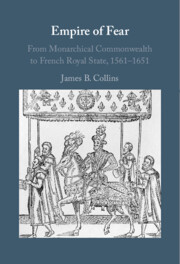Refine search
Actions for selected content:
895 results
4 - The Inaugurators of Scholasticism: Language and Theology in the Twelfth Century
- from Part I - Historical Context
-
-
- Book:
- The Origins of Scholasticism
- Published online:
- 18 November 2025
- Print publication:
- 08 January 2026, pp 116-154
-
- Chapter
- Export citation
Chapter 7 - Control and Protean Power in Small and Large Worlds
-
- Book:
- Entanglements in World Politics
- Published online:
- 27 November 2025
- Print publication:
- 11 December 2025, pp 272-308
-
- Chapter
-
- You have access
- Open access
- HTML
- Export citation
Chapter 2 - Small and Large Worlds, Post-Newtonianism and Para-Humanism
-
- Book:
- Entanglements in World Politics
- Published online:
- 27 November 2025
- Print publication:
- 11 December 2025, pp 63-102
-
- Chapter
-
- You have access
- Open access
- HTML
- Export citation
Introduction
-
- Book:
- Empire of Fear
- Published online:
- 27 November 2025
- Print publication:
- 11 December 2025, pp 1-30
-
- Chapter
- Export citation
Chapter 5 - The Missiles of 1962
-
- Book:
- Entanglements in World Politics
- Published online:
- 27 November 2025
- Print publication:
- 11 December 2025, pp 175-221
-
- Chapter
-
- You have access
- Open access
- HTML
- Export citation
Chapter 2 - Perceptual Reference and Discrimination
-
- Book:
- Kant and the Power of Perception
- Published online:
- 27 November 2025
- Print publication:
- 11 December 2025, pp 51-89
-
- Chapter
- Export citation
From Singing to Speaking: A Song-Based Irish Language Pedagogy in the Diaspora
-
- Journal:
- Traditions of Music and Dance ,
- Published online by Cambridge University Press:
- 05 December 2025, pp. 1-17
-
- Article
- Export citation

Empire of Fear
- From Monarchical Commonwealth to French Royal State, 1561–1651
-
- Published online:
- 27 November 2025
- Print publication:
- 11 December 2025

Weaponizing Language
- Legislating a Hindu India
-
- Published online:
- 27 November 2025
- Print publication:
- 28 August 2025

The Joy of Love in the Middle Ages
- A European Literary History
-
- Published online:
- 20 November 2025
- Print publication:
- 04 December 2025
A Report on Knowledge: Written Reports from the Church of England, 1985–Present
-
- Journal:
- Journal of Anglican Studies , First View
- Published online by Cambridge University Press:
- 18 November 2025, pp. 1-23
-
- Article
- Export citation
17 - Meaning and Emotion
-
-
- Book:
- Explaining the History of American Foreign Relations
- Published online:
- 24 October 2025
- Print publication:
- 13 November 2025, pp 342-362
-
- Chapter
- Export citation

Discourse and Queer Sinophone Male Identities
- A Western Immigrant Perspective
-
- Published online:
- 12 November 2025
- Print publication:
- 11 December 2025
-
- Element
- Export citation
Introduction to “Chronotopes of Gender”
-
- Journal:
- Signs and Society ,
- Published online by Cambridge University Press:
- 06 November 2025, pp. 1-5
-
- Article
-
- You have access
- Open access
- HTML
- Export citation
4 - Geo-strategic Norm-Shaping and the Art of the Subsidy
- from Part I - The Birth of the Petro-State: How Oil Reshaped the Gulf
-
- Book:
- The Gulf's Climate Reckoning
- Published online:
- 13 October 2025
- Print publication:
- 30 October 2025, pp 109-127
-
- Chapter
- Export citation
The perks of being bilingual: Autobiographical memory and aging among bilingual and monolingual Hispanic adults
-
- Journal:
- Journal of the International Neuropsychological Society / Volume 31 / Issue 3 / March 2025
- Published online by Cambridge University Press:
- 30 October 2025, pp. 219-228
-
- Article
-
- You have access
- Open access
- HTML
- Export citation
Chapter 9 - Cassirer on Kant and W. v. Humboldt on Language: “Die Freiheit und Selbständigkeit des geistigen Tuns”
- from Part II - Historical and Philosophical Implications
-
-
- Book:
- Kant on Language
- Published online:
- 19 September 2025
- Print publication:
- 09 October 2025, pp 160-177
-
- Chapter
- Export citation
Chapter 3 - Kant and the Idea of a Language in ‘the Senses’
- from Part I - Linguistic Implications of Kant’s Thought
-
-
- Book:
- Kant on Language
- Published online:
- 19 September 2025
- Print publication:
- 09 October 2025, pp 48-66
-
- Chapter
- Export citation
5 - Episodes in Rival Narratives
-
- Book:
- The Narrative Conflict of Traditions in the Late Antique World
- Published online:
- 22 September 2025
- Print publication:
- 09 October 2025, pp 158-197
-
- Chapter
- Export citation
5 - Introduction to Transcultural Ethnography
- from Part II - Transcultural Ethnography
-
- Book:
- Ethnography in International Business
- Published online:
- 21 October 2025
- Print publication:
- 09 October 2025, pp 127-145
-
- Chapter
- Export citation
